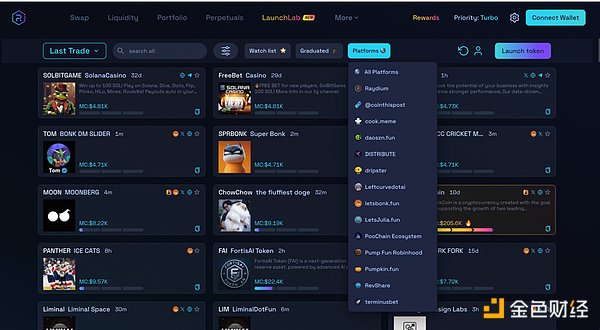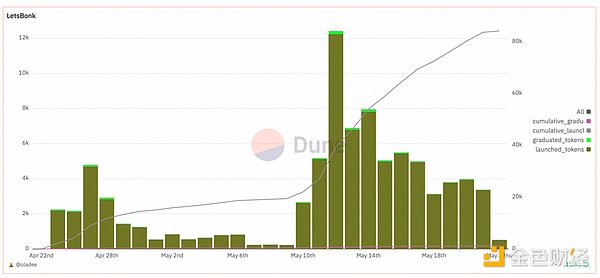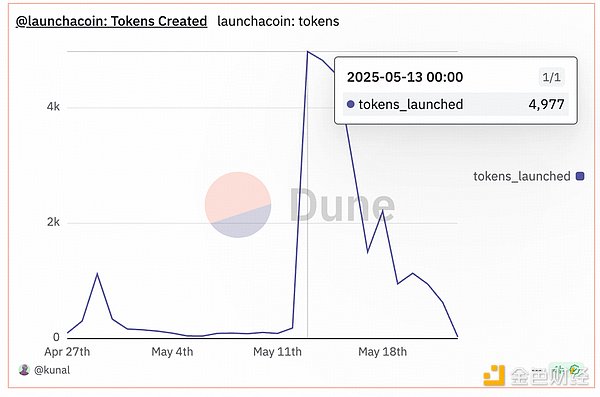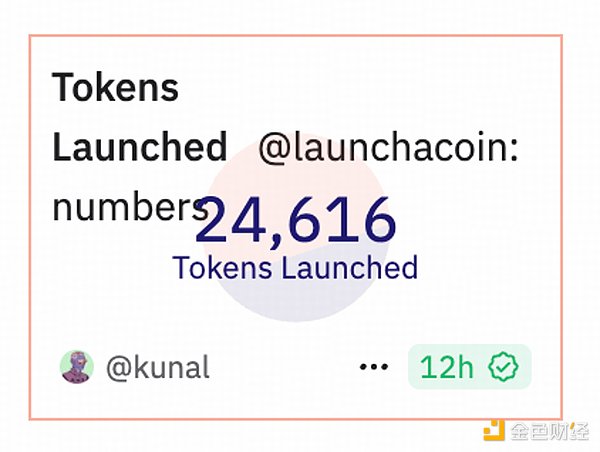Author: TI Research
On-chain MEME Launchpad Analysis
On-chain MEME Launchpad is a decentralized platform built on the blockchain that aims to simplify the creation process of MEME tokens. They provide tools for token creation, pre-sale management, and liquidity provision on decentralized exchanges (DEX) such as Raydium or PancakeSwap, ensuring transparency and accessibility for users.
Functionality of Launch Platforms

The structural advantages of launch platforms are highly consistent with the characteristics of MEME tokens. In particular, their ability to quickly build and mobilize communities complements the high degree of community dependence typical of MEME projects. As a result, MEME-focused launch platforms have gained greater traction than other types of token issuance platforms.
MEME launch platform development record
MEME launch platform emergence and maturity
The emergence of on-chain MEME launch platforms has reshaped the early token distribution model and enabled the rapid, permissionless creation of MEME tokens. Unlike traditional platforms focused on initial decentralized offerings (IDOs), these launch platforms prioritize speed, simplicity, and virality over due diligence or investor protection.
Pump.fun has gained significant attention since mid-2024, even though the most competitive alternatives such as Moonshot and SunPump have only captured a small market share. Pump.fun’s MEME token issuance surges, reaching an unprecedented peak in late 2024 and continuing active into early 2025.

(Data source: https://dune.com/adam_tehc/memecoin-wars)
The rise of new competitors to the MEME launch platform
By late April 2025, the competitive landscape of on-chain MEME launch platforms began to change. New entrants such as LetsBonk (built on Launchlab), Believe (with a strong focus on social media integration), and Boop (with a novel fee-sharing mechanism) have quickly gained traction. Together, these platforms have eroded Pump.fun's previously unchallenged dominance.
According to @adam_tehc on Dune Analytics, Pump.fun's market share fell to an all-time low of 56% on May 12, 2025. Its token graduation rate fell to just 0.82%, far lower than its emerging competitors. Boopdotfun and LetsBONK.fun have significantly higher graduation rates, at 4.41% and 1.45%, respectively. According to TokenInsight, the total market value of MEME tokens has increased by 47% in the past 30 days, and the transaction volume has surged by 160%. The growing activities of MEME launch platforms such as Pump.fun and LaunchLab have ignited speculative sentiment and driven increased participation from retail users. As of May 20, 2025, on-chain transaction volume has increased by 17.3% from the beginning of the month, with the MEME sector being considered the main contributor to this growth (data from Defillama). The following sections will provide a detailed introduction to the core functions, user dynamics, and economic models of each major MEME launch platform.
Head Projects
Pump.fun
Pump.fun has established itself as the largest MEME launch platform on Solana, taking full advantage of Solana's low fees and fast transaction speeds. Since its launch, the platform has facilitated the creation of more than 8 million tokens in just 13 months.
As a leading platform in this field, Pump.fun has pioneered an integrated mechanism that combines token issuance with automatic liquidity migration to decentralized exchanges. Pump.fun lowers the threshold for MEME token creation through a code-free interface tailored for non-technical users. Through a simplified user interface, users only need to upload a name, symbol, and picture to deploy a new token.
Mechanism:
On Pump.fun, the token launch process is fully automated. Through a simplified user interface, users only need to upload a name, symbol, and picture to deploy a new token. The platform adopts a joint curve pricing model driven by supply and demand, and does not include a pre-sale stage, effectively reducing early arbitrage risks.
In its early stages, Pump.fun worked with Raydium. Once the token's market cap reaches $69,000, it will automatically be listed on Raydium (now redirected to PumpSwap) and injected with $12,000 in initial liquidity. The corresponding LP tokens will then be permanently destroyed to ensure fairness and irreversibility. Developers will also receive a reward of 0.5 SOL upon graduation.
This mechanism significantly lowers the threshold for MEME token issuance and has contributed to the rapid rise of Pump.fun in the MEME cycle.
Pump.fun and Raydium Partnership Broken:
The migration of joint curve-based transactions to Raydium liquidity pools highlighted Pump.fun's early reliance on Raydium. While this model initially seemed mutually beneficial, the dynamic has changed significantly with the rise of Pumpswap and Launchlab.
On March 21, Pump.fun announced the launch of its native AMM DEX, PumpSwap. After this update, the liquidity of tokens graduated from the Pump.fun platform is no longer routed to Raydium, but redirected to PumpSwap.
In response, Raydium officially launched its token launch platform LaunchLab on April 16. This marks the beginning of direct competition between Pump.fun and Raydium.
LaunchLab
LaunchLab adopts a roughly similar mechanism to Pump.fun, using an automated joint curve model for token issuance and pricing. As a token launch platform, its core issuance process does not introduce fundamental new features.
Its main competitive advantage lies in its modular architecture, which enables seamless third-party integration and supports highly customizable issuance configurations, providing flexibility for developers seeking customized token issuance solutions.
Mechanism:
Third-party integration: LaunchLabs' core advantage lies in its architecture that supports third-party integration. According to its web interface, LaunchLab has integrated with more than 10 third-party platforms. A major example is LetsBONK.fun, a MEME launch platform created by the $BONK community, which is built on LaunchLab's infrastructure.

(Data source: https://raydium.io/launchpad/)
Highly Customizable: In addition, LaunchLab further improves its launch framework by providing two different modes:
JustSendIt Mode: Designed for standardization and rapid issuance, this mode allows users to launch tokens with minimal configuration, catering to casual or first-time creators.
LaunchLab Mode: Supports custom parameters, including total token supply, proportion of tokens allocated to the bonding curve, and token lock settings. Notably, under LaunchLab mode, developers are entitled to 10% of LP transaction fees upon token graduation, providing stronger incentives for high-quality project creation.
LetsBONK.fun - Third-Party Integration Representative:
According to @oladee, LetsBONK.fun facilitates the creation of more than 12,000 tokens per day, and the total number of tokens issued has exceeded 80,000. At its peak, the platform captured 29% of the daily market share. Projects such as $Hosico and $USELESS were among the top performers among the tokens that successfully graduated.

(Data source: https://dune.com/oladee/lets-bonk)
LaunchLab vs. Pump.fun:
LaunchLab did not introduce any fundamentally new mechanisms and only has a slight advantage in fee structure. However, on May 12, Pump.fun announced that it would share 50% of its revenue with token creators, which effectively offset LaunchLab's fee advantage. This strategic move has brought Pump.fun's market share back to over 80%, marking a major reversal of the competitive landscape.
LaunchLab has adopted a strategy of actively promoting third-party platforms to jointly weaken Pump.fun's market position. Although this approach has put some revenue pressure on Pump.fun, LaunchLab is unlikely to challenge Pump.fun's dominance in the short term due to a lack of meaningful product innovation.
Believe
Believe, formerly known as Clout, is a SocialFi platform developed by Ben Pasternak that focuses on celebrity token issuance. The project was announced on April 27, 2025. It received significant attention upon release, with Solana official accounts, Solana co-founder Anatoly Yakovenko (Toly), and Jupiter co-founder Meow all retweeting it. Since its launch, the Believe platform has facilitated the issuance of more than 24,000 tokens, with a peak daily issuance of nearly 5,000 and a maximum market share of 13.6% (data from @kunal).


(Data source: https://dune.com/kunal/launchacoin)
Mechanism:
Believe’s token launch adopts a socially driven distribution model, through its “X Trigger” mechanism, allowing users to deploy tokens on the Solana blockchain simply by posting a tweet with @LaunchACoin on X (formerly Twitter) and specifying the token name. The entire process is automatically executed through the backend service.
The platform uses a dynamic bonding curve model with high initial transaction fees, designed to prevent robot buying. As transaction volume increases, the fees gradually decrease and stabilize at 2%. This mechanism promotes fair market participation and mitigates early manipulation.
Once the market value of the token exceeds $100,000, it will be automatically listed on the Meteora exchange platform. Developers are incentivized by sharing 1% of the total transaction fees (2%).
MakeNow.Meme: The Fall of the First X Trigger MEME Launchpad:
Amid the emergence of numerous launchpads copying the Pump.fun model, Believe stands out for introducing a more innovative launch mechanism. However, it is worth noting that Believe is not the first platform to adopt an X-based token launch model. That honor belongs to MakeNow.Meme, which briefly became popular in 2024 and pioneered this approach.
MakeNow was a project that allowed users to launch tokens through tweets on X. It used a dynamic bonding curve and zero-cost creation, offering a novel and accessible model. However, despite early attention, the project quickly fell within a week. The main reasons for its short-lived popularity can be attributed to two points:
Lack of anti-buying mechanisms: The platform has not implemented effective anti-bot buying measures. The delay before the contract address is released allows insiders to purchase low-cost tokens in advance, creating an unfair advantage.
Lack of ecosystem and community support: MakeNow lacks a dedicated user community or broader ecosystem support.
Believe has gained market acceptance by addressing the core flaws of its predecessor. It builds on the foundation of the earlier SocialFi platform and benefits from the ecosystem support of Solana and Jupiter. In addition, its use of dynamic bonding curves helps mitigate robot buying in the early stages of token trading, improving fairness and issuance integrity.
Boop.Fun
Boop.Fun is a MEME token launch platform developed by Dingaling, co-founder of PancakeSwap.
Mechanism:
Boop.Fun integrates the core mechanisms of Pump.fun and Believe, providing two issuance channels: creating tokens directly through the platform, or triggering on-chain deployment by posting tweets with @beeponboop on X.
The platform's native token $BOOP is the basis of its incentive system. Creators of active tokens receive $BOOP airdrops daily, while holders receive rewards proportional to their token holdings, encouraging long-term participation. In addition, users who stake $BOOP can participate in daily airdrops and share 60% of the platform's SOL transaction fee revenue, establishing a multi-tiered reward structure.
Reputational Pressure:
Recently, the founder of Boop.Fun, who goes by the online name "dingaling," claimed to have served as Binance's Chief Risk Officer (CRO). However, Binance CEO CZ publicly refuted the claim that the position existed and suggested that the founder was fired for suspected insider trading. Although the matter has not yet been resolved, the controversy has had a significant impact on the platform: daily active users have dropped by 56%, and token issuance has dropped sharply from 10,877 to 1,072 - a 90% drop. As a result, market performance became unstable and the community's trust in Boop.Fun declined significantly.
Which one is better?

Although Pump.fun remains the dominant player in the MEME launch platform space, Believe has a relative competitive advantage among new entrants.
Pump.fun: The creator profit sharing mechanism introduced by Pump.fun partially offsets the costs associated with token issuance and migration. In addition, this mechanism provides creators with stronger incentives to launch and maintain higher quality tokens.
LaunchLab: While low issuance fees, low graduation standards, and zero migration fees may be attractive to creators, they also lower the barrier to entry, leading to the proliferation of "scam" or "pump and dump" projects. This harms the overall project quality. In the absence of core innovation or differentiation, the platform may face challenges in maintaining long-term growth and competitiveness.
Believe: Believe is built on a new token launch mechanism, introduces a dynamic bonding curve to discourage early bot buying, and sets a higher graduation threshold. These measures address key issues observed in MakeNow.Meme and enhance user protection. Despite relatively high transaction fees, the platform's design tradeoffs have resulted in net gains in fairness and sustainability.
BOOP: Boop.Fun offers a highly integrated platform design with an attractive token distribution model in the short term. However, the platform's performance is closely tied to the price performance of its native token $BOOP, which increases exposure to risks such as insider trading and damaged community trust. These concerns have been amplified during the recent negative publicity, during which the platform's overall performance has significantly declined.
Conclusion
For a MEME launch platform to achieve long-term viability, it must be built on strong core mechanisms or technological innovations that can effectively solve current market challenges. For example, Pump.fun has pioneered an integrated mechanism that combines token issuance with automatic liquidity migration to decentralized exchanges. And Believe optimizes a simple token issuance process driven by social media. Pump.fun remains the leading platform in the MEME launch platform space, while Believe shows strong growth momentum and has the potential to gain more market share in the long term.
Key Challenges Facing MEME Token Launch Platforms
Currently, MEME launch platforms face two fundamental challenges:
User Protection Mechanisms: Due to the inherent low threshold and high risk nature of MEME tokens, platforms must mitigate user losses by addressing project quality and transaction fairness. This requires the implementation of strong project screening mechanisms, such as team background verification, smart contract audits, and reputation scoring systems to screen out fraudulent or low-quality projects. In addition, anti-bot mechanisms such as address whitelisting, KYC procedures, and transaction rate limits are critical to ensure fair access and prevent manipulation during initial token sales.
Multi-chain deployment capabilities: Most platforms are still limited to a single blockchain, limiting scalability and user coverage. Expanding to a multi-chain architecture enables broader accessibility and cost optimization, but also brings technical barriers such as cross-chain security, data consistency, and fragmented user experience. Solutions include integrating cross-chain protocols (such as LayerZero, Axelar) and adopting a modular blockchain framework while ensuring unified wallet support and seamless interfaces. Effective multi-chain expansion is critical to the long-term growth of the MEME token ecosystem.
Looking ahead, MEME launch platforms that can solve the above core challenges, or introduce innovative mechanisms to reshape user and developer incentives, may also stand out in the evolving on-chain launch landscape and become players worth paying attention to.
 Anais
Anais










